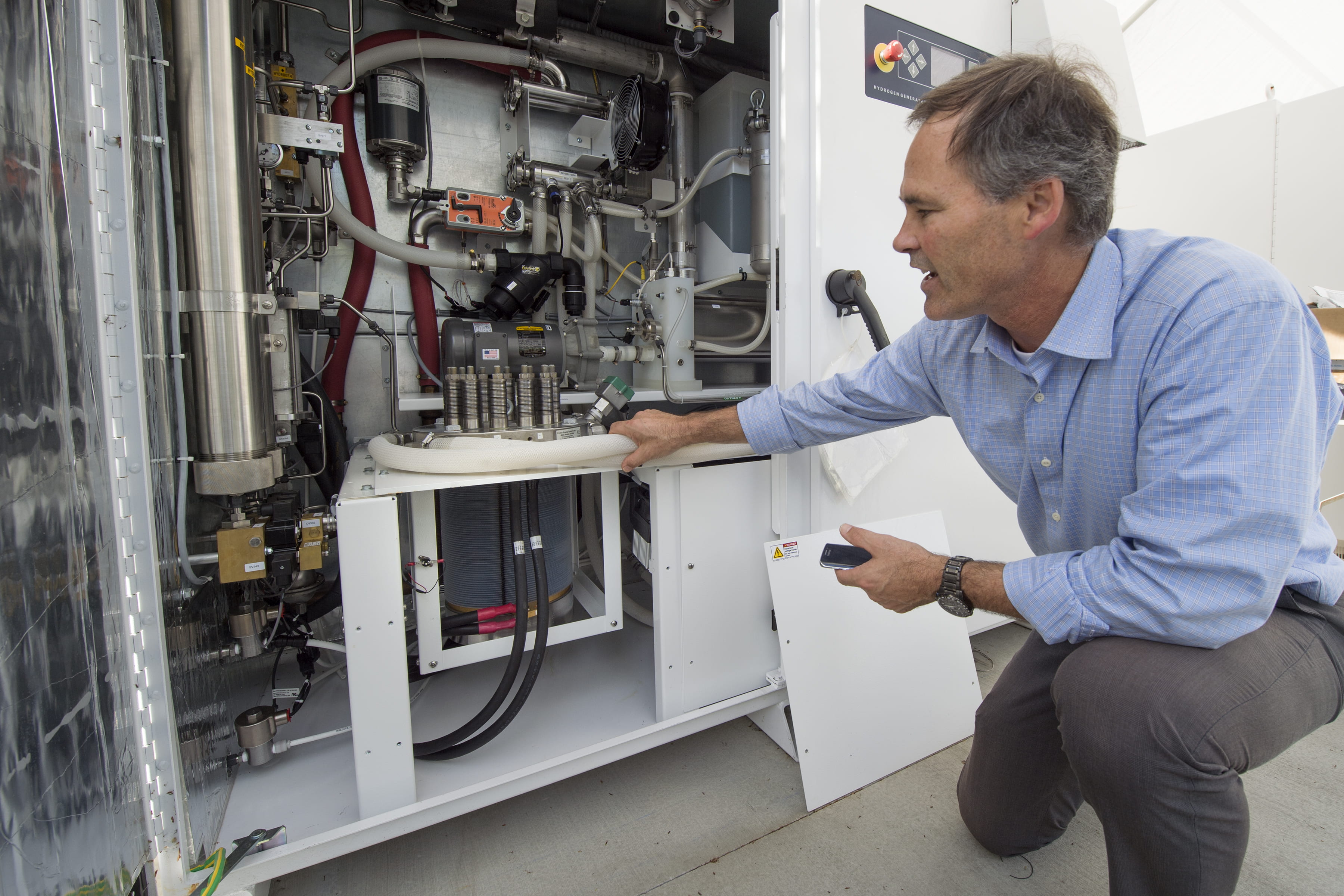Greening the grid
UCI tests integration of renewable hydrogen into existing natural gas systems

There are lots of different kinds of laboratories at the University of California, Irvine, but a unique one being used by Advanced Power & Energy Program researchers also happens to generate partly renewable electricity and heat for the campus.
UCI’s power plant has been made available to APEP engineers so they can study the safety and effectiveness of power-to-gas, a process in which excess wind or solar electricity is utilized to create hydrogen, a carbon-free resource that can be injected into existing natural gas infrastructure that supplies homes, utilities and alternative-fuel vehicles.
“It’s really cool that the university lets us conduct research in the main campus power plant,” says Jack Brouwer, APEP’s associate director. “I have colleagues at other institutions who are envious of the opportunity we have here at UCI.”

Steve Zylius / UCI
The underlying goal of the project is to better understand the role P2G can play in making renewable energy a normal part of infrastructure already in place. The relatively new technology has already shown promise as a way to take advantage of green power that would otherwise go to waste.
“One of the big challenges we’ve faced in adding wind and solar to the grid is what to do with the excess electricity,” Brouwer says. “We’ve shown you need not halt renewable power generation when demand is low. Instead, the excess electricity can be used to make hydrogen that can be easily integrated into existing natural gas pipelines.”
The pilot project began last summer with funding from the Southern California Gas Co. and the participation of Proton OnSite, provider of an electrolyzer that creates hydrogen from electricity and water. APEP engineers worked with Facilities Management technicians to install the P2G equipment adjacent to the campus’s power plant. Since then, the process has been closely monitored by researchers trying to determine whether P2G is feasible on statewide or regional power grids. Such systems are currently in place in Germany and Canada.
“Our initial testing indicates smooth operation for this first successful U.S. proof of concept,” says Brouwer, associate professor of mechanical & aerospace engineering. “Storage of the hydrogen in existing natural gas infrastructure could produce a massive hydrogen battery that could become the most important technology for enabling a 100 percent renewable future.”
The central component of the process is the electrolyzer, which takes in water and uses excess clean electricity to power an electrochemical reaction that splits it into hydrogen and oxygen. The latter is released into the atmosphere, and the hydrogen is compressed and sent about 60 feet through a pencil-thin, stainless steel tube to an injection point in UCI’s natural gas pipeline. The hydrogen is mixed with natural gas and burned in the gas turbine power plant to generate electricity and heat for the campus.
“This research lays the groundwork for leveraging the natural gas infrastructure already in place for the storage and transmission of renewable energy,” says Jeff Reed, director of business strategy and advanced technology at the Southern California Gas Co.
One of the advantages of P2G, according to Brouwer, is that it’s relatively easy to integrate it into existing natural gas infrastructure. Excess power produced by large wind and solar farms in the deserts of California’s southeastern corner could be introduced into the massive natural gas pipeline that runs from the Arizona border – eliminating the need for any new construction.
“If you injected hydrogen into that main line, you’d be ‘storing’ it almost in the whole SoCalGas system, because it would be mixed and diluted into all the other streams,” Brouwer says.
A team of UCI students will continue monitoring the on-campus P2G process and conduct research in related topics – such as the effect of hydrogen transport on natural gas pipelines. Like other kinds of infrastructure, gas lines degrade over time, requiring regular maintenance and replacement about every 100 years. Smaller hydrogen molecules penetrate deeper into tiny cracks in pipes, potentially shortening their lifespan. APEP scientists are working to determine the optimum hydrogen concentrations and pressure settings to ensure system longevity.
They’re also studying methanation, the conversion of carbon dioxide and renewable hydrogen into a new, sustainable fuel source. Brouwer says it’s possible to take CO2 out of the atmosphere near a power plant exhaust stack and combine it with hydrogen created by an electrolyzer to produce renewable methane that’s 100 percent compatible with existing infrastructure.
“UCI’s power-to-gas project is showing that there are technologies in development today that offer ways to drastically increase the use of environmentally sensitive wind and solar resources in power generation and delivery,” says Scott Samuelsen, APEP director and professor of mechanical & aerospace engineering. “It’s particularly rewarding to see this exciting technology being implemented and evaluated right here.”